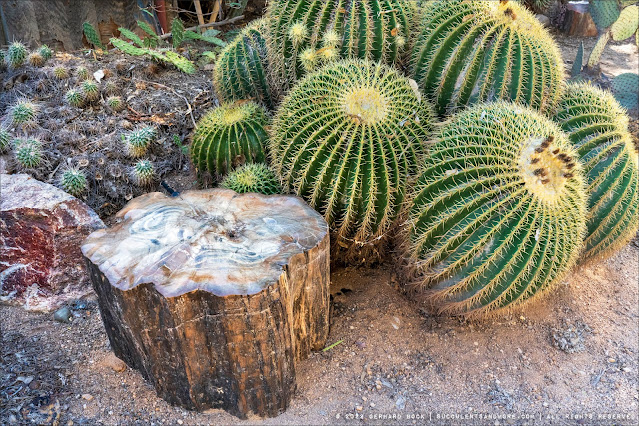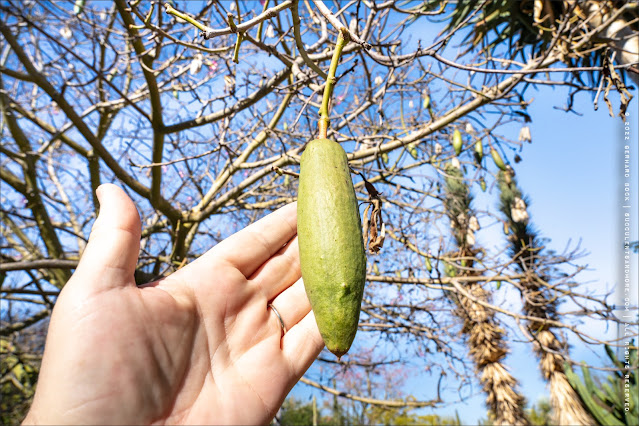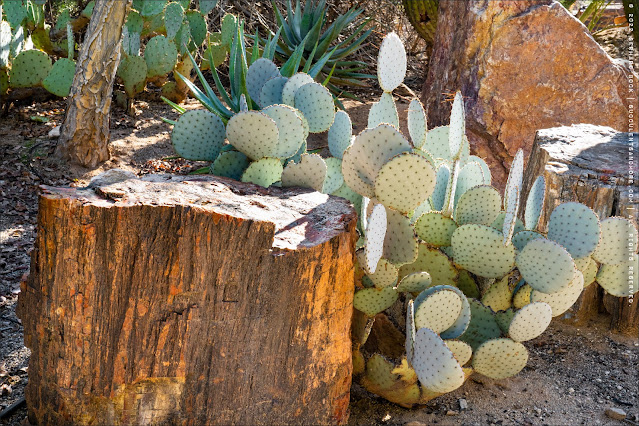As you saw in my previous post, Bach’s Greenhouse Cactus Nursery in Tucson, Arizona has a massive inventory of cacti and other succulents. But they also have spectacular specimen plantings throughout their 11-acre property. I don’t know how long Bach’s has been at this site, but many of the trees and cacti are decades old.
In addition to plants, you’ll see many pieces of petrified wood, ranging in size from 2-foot rounds to entire logs. On a previous visit, I was told that the petrified wood came from the estate of a collector and that it is for sale. Maybe next time I should ask what the going rate is—I have a feeling I’ll be shocked, considering that pieces this large and of this quality are not common.
In any case, as you can see in many of the photos below, petrified wood complements succulents very nicely!
 |
| Golden barrels and petrified wood, what could be better? I can’t wait for the golden barrel babies on the left to grow up to meld with the existing clump. |
 |
| One of the most colorful pieces of petrified wood |
 |
| “Stick cactus” (Peniocereus?) |
 |
| These stick cacti may not look like much, but they typically have amazing flowers |
 |
| I don’t have a positive ID on the agave, but it has the stately presence of Agave franzosinii |
 |
| Aloe suzannae, one of the rarer and more challenging aloes in cultivation, growing happily under a spectacular Yucca thompsoniana |
 |
| Silk floss tree (Ceiba speciosa) has... |
 |
| ...pretty flowers... |
 |
| ...fierce prickles on the trunk... |
 |
| ...and appropriately strange fruits |
 |
| Another Ceiba speciosa (and hundreds of new nursery containers) |
 |
| Ceiba speciosa and Aloidendron ‘Hercules’ |
 |
| I’ve never seen a quiver tree (Aloidendron dichotomum) with so many flowers |
 |
| The flowers are a pure yellow... |
 |
| ...a hue some people call “canary yellow” |
 |
| Lizard on petrified wood |
 |
| Petrified wood detail |
 |
| Split petrified wood log |
 |
| A particularly attractive totem pole cactus (Lophocereus schottii f. monstrosus) |
 |
| Totem pole cactus with Dioon edule |
 |
| Another Dioon contrasting beautifully with the petrified wood |
 |
| If I had to pick a favorite vignette, it would be this one: these Agave parryi are perfection |
 |
| Petrified wood and prickly pears... |
 |
| ...another winning combination |
 |
| This is the regular (non-monstrose) form of the totem pole cactus (Lophocereus schottii). It’s native to southern Arizona and northwestern Mexico, particularly in Sonora and Baja California. Its common name is senita. |
 |
| One of my favorite display beds at Bach’s: senita (Lophocereus schottii), golden barrel (Echinocactus grusonii), and silver cholla (Cylindropuntia echinocarpa) |
 |
| I have no idea what these rocks are, but they look like something you’d find under the sea. The cactus is Mammillaria geminispina. |
Bach’s is a must-see Tucson attraction for anybody even slightly interested in succulents. It’s located at
8602 N Thornydale Road. See
their website for current hours.
RELATED POST:
© Gerhard Bock, 2022. All rights reserved. To receive all new posts by email, please subscribe here.




























In photo 5, behind the noID agave, (with "stately presence of Agave franzosinii"), I see trees with very chartreuse trunks. Do you know what those are?
ReplyDeleteThe blooming Aloidendron dichotomum is amazing, and I love the common name, quiver tree. Is that because of the feeling one gets when seeing it in full bloom?
The petrified wood throughout is so magnificent, it doesn't play second fiddle to anything: definitely centers stage star power.
Chavli
I wish I knew what the trees behind Agave franzosinii are. They're beautiful!
DeleteThe name "quiver tree" comes from the San people in South Africa hollowing out the branches of Aloidendron dichotomum to make quivers for their arrows.
I love that photo with the totem pole cactus clump, it really is the best looking bunch of monstros Lophocereus schottii I've seen. I hope my tall one is going to make it, I left it out in the rain a little to long this fall before bringing it in.
ReplyDeleteI'd love an offset from that totem pole cactus. Very few have such a beautiful uniform look.
DeleteI love how all the nurseries you visit have display gardens. Not the case here in my neck of the woods. The rock in the second to last photo looks like tufa. It is made by dripping mineral rich springs, caught decaying plant matter and algae. It is very porous and plants, especially alpine/rock garden plants love to grow in it. Have never seen an Aloidendron tree bloom. Pretty spectacular.
ReplyDeleteI imagine that if that petrified wood was reasonably priced, it'd be long gone by now...The quiver trees are impressive. I'm always attracted to silver chollas in photos but I'm afraid to plant one in my own garden as I can't identify a spot that safe for me to navigate, much less visitors.
ReplyDeleteWow! I have been to Bach's a number of times. When I was last there (a few years ago) most of the petrified wood was in a big jumble in one spot. They have done a fantastic job with interspersing it with the plants! I have not seen small Silk floss tree (Ceiba speciosa) before. So cool! I have a small quiver tree in a pot. Need to get it planted in the ground-- if I can find a spot!
ReplyDelete